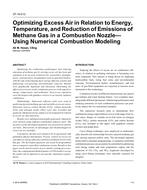Click here to purchase
Human exposure to volatile organic compounds (VOCs) can lead to adverse health effects such as breath shortness and asthma. Some gases react with VOCs indoors, generating chemical products which cause eye and skin irritation. Despite the fact that indoor chemical reactions affect VOCs concentration and human health, little information is available about formations of reactive gases and distributions of reaction products in building systems. The objectives of this study are to investigate 1) indoor generation of reactive gas (hydroxyl radical (OH radical)) in various lighting conditions and 2) distributions and concentrations of reaction products under varied ventilation conditions. Computational fluid dynamics (CFD) model is used to simulate chemical reactions in a ventilated room, while chemical reaction rate coefficients are applied to the model based on experimental data. The model simulates that photolysis of nitrous acid (HONO) generates OH radicals in a part of the ventilated room influenced by direct solar radiation. The study results reveal the concentrations of products from the reaction between OH radicals and VOCs under varying solar incidence angles, air change rate, and supply inlet position. The results show that HONO molecules are decomposed into OH radicals and nitric oxide (NO) in the solar radiation zone of the room. The products are generated in the solar radiation zone and diffused to other zones. As the direct solar radiation area increases, more OH radicals are produced, thereby increasing reaction product concentrations in the room.
Citation: 2019 Winter Conference, Atlanta, GA, Conference Papers
Product Details
- Published:
- 2019
- Number of Pages:
- 7
- Units of Measure:
- Dual
- File Size:
- 1 file , 1.4 MB
- Product Code(s):
- D-AT-19-C010


